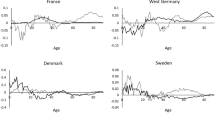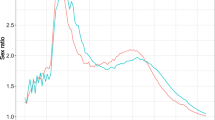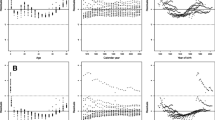Abstract
Mortality forecasts are critically important inputs to the consideration of a range of demographically-related policy challenges facing governments in more developed countries. While methods for jointly forecasting mortality for sub-populations offer the advantage of avoiding undesirable divergence in the forecasts of related populations, little is known about whether they improve forecast accuracy. Using mortality data from ten populations, we evaluate the data fitting and forecast performance of the Poisson common factor model (PCFM) for projecting both sexes’ mortality jointly against the Poisson Lee–Carter model applied separately to each sex. We find that overall the PCFM generates the more desirable results. Firstly, the PCFM ensures that the projected male-to-female ratio of death rates at each age converges to a constant in the long run. Secondly, using out-of-sample analysis, we find that the PCFM provides more accurate projection of the sex ratios of death rates, with the advantage being greater for longer-term forecasts. Thus the PCFM offers a viable and sensible means for coherently forecasting the mortality of both sexes. There are also significant financial implications in allowing for the co-movement of mortality of females and males properly.










Similar content being viewed by others
Notes
As in Kleinow (2015), a possible extension to the PCFM structure is to use the same age effect for both sexes, i.e. \(b_{x,1,j} = b_{x,2,j}\). This simplification may further improve the BIC values when the data fitting period is very short and the \(b_{x,i,j}\) patterns are similar between females and males.
In our parameter estimation, the model structure of n = 0 is fitted initially. Then, treating the estimated parameters as known quantities, the additional factors are incorporated into the model structure and these new parameters are computed. There are no convergence problems during the process.
As in Li (2013), we use the same number of additional factors for both sexes in this paper. As a possible extension to the initial PCFM structure, we further test the cases where the number of additional factors of one sex is different to the other. For the ten populations studied in the next section, only two require different numbers of additional factors between the two sexes to achieve the lowest BIC value. Since the trends of the corresponding higher-order additional factors required for these two populations are quite irregular, we choose to simply use the same number of additional factors for both sexes and leave the possible extension for future research.
One may assume that \(\varepsilon_{t}\) and \(\omega_{t,i,j}\) are independent, as in Li and Lee (2005) and Li (2013), or alternatively that they follow a certain correlation structure. This assumption would not affect our analysis, as we focus on the accuracy and reasonableness of the mean forecasts but not the variability.
The MAPE of the fitted log death rates is defined similarly as in (9).
Though the extents are very different, both the PCFM and the Poisson Lee-Carter model produce residuals with some systematic effects along the cohort year. Cohort terms (e.g. Renshaw and Haberman 2006) may be added to improve the model fitting.
The (period) life expectancy value is calculated as \(\sum\nolimits_{t = 0} {{}_{t + 0.5}p_{x} }\), where \({}_{t}p_{x}\) are (period) survival probabilities (of age x for t years) estimated from the observed death rates or projected death rates.
The cohorts considered are not extinct and so the corresponding life expectancy values computed are limited by the data period. For example, the value calculated for an Australian born in 1995 can be interpreted as the number of years expected to be lived within 13 years (but not the entire lifespan).
References
Australian Productivity Commission. (2013). An ageing Australia: Preparing for the future. Productivity commission research paper. Canberra: Commonwealth of Australia. http://www.pc.gov.au/__data/assets/pdf_file/0005/129749/ageing-australia.pdf. Cited 23 May 2014.
Australian Treasury. (2010). Australia to 2050: Future challenges. Canberra: Commonwealth of Australia. http://www.treasury.gov.au/igr/igr2010/report/pdf/IGR_2010.pdf. Cited 22 May 2014.
Australian Treasury. (2013). Secure and sustainable pension reform: Age pension age. Canberra: Commonwealth of Australia. http://ministers.treasury.gov.au. Cited 22 May 2014.
Australian Treasury. (2014). Budget speech 2014–15. Canberra: Commonwealth of Australia. http://www.budget.gov.au/2014-15/content/speech/html/speech.htm. Cited 22 May 2014.
Bongaarts, J. (2006). How long will we live? Population and Development Review, 32(4), 605–628.
Booth, H., Maindonald, J., & Smith, L. (2002). Applying Lee–Carter under conditions of variable mortality decline. Population Studies, 56(3), 325–336.
Booth, H., & Tickle, L. (2008). Mortality modelling and forecasting: A review of methods. Annals of Actuarial Science, 3(1–2), 3–43.
Brouhns, N., Denuit, M., & Vermunt, J. K. (2002). A Poisson log-bilinear regression approach to the construction of projected lifetables. Insurance: Mathematics and Economics, 31(3), 373–393.
Carter, L. R., & Lee, R. D. (1992). Modeling and forecasting US sex differentials in mortality. International Journal of Forecasting, 8(3), 393–411.
European Commission Economic Policy Committee. (2006). The impact of ageing on public expenditure: Projections for the EU25 Member States on pensions, health care, long-term care, education and unemployment transfers (2004–2050). Special report no 1. 2006. Brussels: European Commission. http://ec.europa.eu/economy_finance/publications/publication6654_en.pdf. Cited 23 May 2014.
Griffiths, P., Matthews, Z., & Hinde, A. (2000). Understanding the sex ratio in India: A simulation approach. Demography, 37(4), 477–488.
Guillot, M. (2002). The dynamics of the population sex ratio in India, 1971–96. Population Studies, 56(1), 51–63.
Hamilton, J. D. (1994). Time series analysis. Princeton: Princeton University Press.
Human Mortality Database (HMD). (2013). University of California, Berkeley (USA) and Max Planck Institute for Demographic Research (Germany). www.mortality.org.
Hyndman, R. J., Booth, H., & Yasmeen, F. (2013). Coherent mortality forecasting: The product-ratio method with functional time series models. Demography, 50(1), 261–283.
Kleinow, T. (2015). A common age effect model for the mortality of multiple populations. Insurance: Mathematics and Economics, 63, 147–152.
Lee, R. D., & Carter, L. R. (1992). Modeling and forecasting U.S. mortality. Journal of the American Statistical Association, 87(419), 659–671.
Lee, R., & Miller, T. (2001). Evaluating the performance of the Lee–Carter method for forecasting mortality. Demography, 38(4), 537–549.
Lee, R. D., & Tuljapurkar, S. (2000). Population forecasting for fiscal planning: Issues and innovations. In A. Auerbach & R. Lee (Eds.), Demography and fiscal policy (pp. 7–57). Cambridge: Cambridge University Press.
Li, J. (2010). Projections of New Zealand mortality using the Lee–Carter model and its augmented common factor extension. New Zealand Population Review, 36, 27–53.
Li, J. (2013). A Poisson common factor model for projecting mortality and life expectancy jointly for females and males. Population Studies, 67(1), 111–126.
Li, J. (2014a). A quantitative comparison of simulation strategies for mortality projection. Annals of Actuarial Science, 8(2), 281–297.
Li, J. (2014b). An application of MCMC simulation in mortality projection for populations with limited data. Demographic Research, 30, 1–48.
Li, J., & Haberman, S. (2015). On the effectiveness of natural hedging for insurance companies and pension plans. Insurance: Mathematics and Economics, 61, 286–297.
Li, N., & Lee, R. (2005). Coherent mortality forecasts for a group of populations: An extension of the Lee–Carter method. Demography, 42(3), 575–594.
Li, N., Lee, R., & Tuljapurkar, S. (2004). Using the Lee–Carter method to forecast mortality for populations with limited data. International Statistical Review, 72(1), 19–36.
OECD. (2013). Pensions at a glance 2013: OECD and G20 indicators. OECD Publishing. http://dx.doi.org/10.1787/pension_glance-2013-en. Accessed May 24, 2014.
Opeskin, B., & Kippen, R. (2012). The balance of the sexes: The feminisation of Australia’s population, 1901–2008. Population, Space, and Place, 18(5), 517–533.
R Development Core Team. (2015). R: A language and environment for statistical computing. Vienna, Austria: The R Foundation for Statistical Computing. www.r-project.org.
Renshaw, A., & Haberman, S. (2003a). Lee–Carter mortality forecasting: A parallel generalized linear modelling approach for England and Wales mortality projections. Applied Statistics, 52(1), 119–137.
Renshaw, A. E., & Haberman, S. (2003b). Lee–Carter mortality forecasting with age-specific enhancement. Insurance: Mathematics and Economics, 33, 255–272.
Renshaw, A. E., & Haberman, S. (2006). A cohort-based extension to the Lee–Carter model for mortality reduction factors. Insurance: Mathematics and Economics, 38(3), 556–570.
Renshaw, A. E., & Haberman, S. (2008). On simulation-based approaches to risk measurement in mortality with specific reference to Poisson Lee–Carter modelling. Insurance: Mathematics and Economics, 42(2), 797–816.
Scherbov, S., Sanderson, W. C., & Mamolo, M. (2014). Quantifying policy trade-offs to support aging populations. Demographic Research, 30(20), 579–608.
Stoeldraijer, L., Van Duin, C., van Wissen, L., & Jansen, F. (2013). Impact of different mortality forecasting methods and explicit assumptions on projected future life expectancy: The case of the Netherlands. Demographic Research, 29(13), 323–354.
Tickle, L., & Booth, H. (2014). The longevity prospects of Australian seniors: An evaluation of forecast method and outcome. Asia-Pacific Journal of Risk and Insurance. doi:10.1515/apjri-2013-0004.
Tuljapurkar, S., Li, N., & Boe, C. (2000). A universal pattern of mortality decline in the G7 countries. Nature, 405, 789–792.
United Kingdom Department for Work and Pensions. (2013). Reviewing the state pension age. https://www.gov.uk/government/policies/reviewing-the-state-pension-age. Cited 22 May 2014.
Woods, C., & Dunstan, K. (2014). Forecasting mortality in New Zealand. Statistics New Zealand working paper no 14–01. http://www.stats.govt.nz/methods/research-papers/working-papers-original/forecasting-mortality-14-01.aspx. Cited 26 May 2014.
Yang, B., Li, J., & Balasooriya, U. (2014). Cohort extensions of the Poisson common factor model for modelling both genders jointly. Scandinavian Actuarial Journal. doi:10.1080/03461238.2014.908411.
Acknowledgments
The authors would like to thank the anonymous referees for their valuable comments and suggestions, which greatly enhance the presentation of this paper. The authors also gratefully acknowledge financial support from the Institute of Actuaries of Australia via an Australian Actuarial Research Grant. Finally, the authors thank Daniel Ciarliero for his excellent assistance in this research project.
Author information
Authors and Affiliations
Corresponding author
Rights and permissions
About this article
Cite this article
Li, J., Tickle, L. & Parr, N. A multi-population evaluation of the Poisson common factor model for projecting mortality jointly for both sexes. J Pop Research 33, 333–360 (2016). https://doi.org/10.1007/s12546-016-9173-0
Published:
Issue Date:
DOI: https://doi.org/10.1007/s12546-016-9173-0




